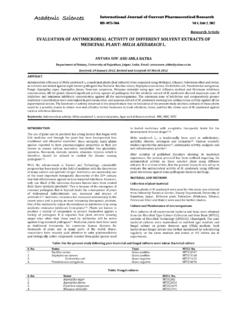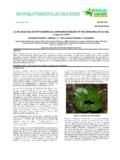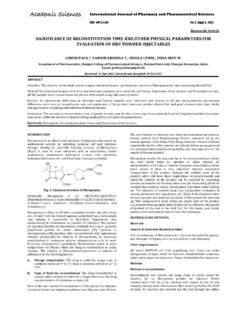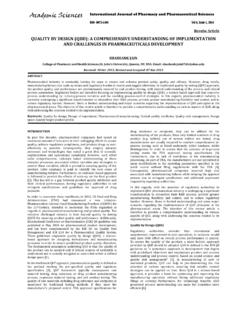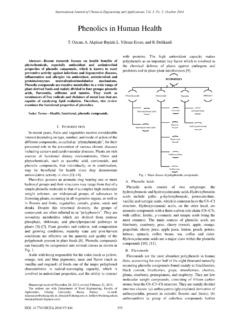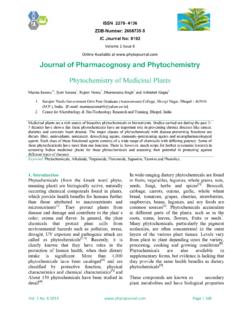Transcription of REDUCING POWER OF THE SOLVENT EXTRACTS OF …
1 Research Article REDUCING POWER OF THE SOLVENT EXTRACTS OF EICHHORNIA CRASSIPES (MART.) SOLMS P. JAYANTHI AND P. LALITHA Department of Chemistry, Avinashilingam Deemed University for Women, Coimbatore Assistant Professor (SS), Department of Chemistry, Avinashilingam Deemed University for Women, Coimbatore, Tamilnadu, India. Received: 21 Feb 2011, Revised and Accepted: 24 March 2011 ABSTRACT REDUCING POWER assay of SOLVENT EXTRACTS of Eichhornia crassipes (Mart.) Solms at different concentrations and time delay was evaluated. REDUCING POWER was linearly proportional to the concentration and time and was found to increase with increase in concentration and time.
2 The EXTRACTS were compared to standard antioxidant L ascorbic acid. All EXTRACTS showed greater REDUCING POWER than that of the standard. The results suggest the potential of development of useful natural antioxidants. Keywords: Eichhornia crassipes, Antioxidant INTRODUCTION Free radicals are types of Reactive Oxygen Species (ROS), which include all highly reactive, oxygen containing molecules. Types of ROS include the hydroxyl radical, the super oxide anion radical, hydrogen peroxide, singlet oxygen, nitric oxide radical, hypochlorite radical, and various lipid eroxides. These free radicals may either be produced by physiological or biochemical processes or by pollution and other endogenous sources.
3 All these free radicals are capable of reacting with membrane lipids, nucleic acids, proteins and enzymes and other small molecules, resulting in cellular damage1. Antioxidants prevent the human system by neutralizing the free radicals interactively and synergistically. Plants are rich source of free radical scavenging molecules such as vitamins, terpenoids, phenolic acids, lignins, stilbenes, tannins, flavanoids, quinones, coumarins, alkaloids, amines, betalains and other metabolites which are rich in antioxidant activity2. Eichhornia crassipes (Mart.) Solms is a free floating perennial aquatic herb. Phytochemical studies carried out revealed the presence of flavanoids and other metabolites in the plant extract3.
4 2,5dimethoxy 4 phenylbenzoindenone isolated from water hyacinth was found to possess antimicotic activity4. 4,9 dimethoxy 7 phenyl 2,3dihydrophenalen 1 olo O methyl ether, 4,9 dimethoxy 7 (4 methoxy phenyl) 2,3 dihidro phenalen l olo O methyl ether, 4,5 dimethoxy 9 phenyl 2,3 dihydro phenalen 1 ol O methyl ether which were isolated from water hyacinth was found to show antialgal activity5. This present study, therefore aimed at the evaluation of the REDUCING POWER of the SOLVENT EXTRACTS of Eichhornia crassipes (Mart.) Solms at various concentrations and time delay. MATERIALS AND METHODS Plant collection Six tonnes of fresh water hyacinth was collected from Singanallur boat house, Coimbatore, Tamilnadu.
5 The root portion was cut off and the plant was washed thoroughly to free from debris. The leaves and shoot portion were shade dried for 20 days. The dried plant material was sliced, ground coarsely and stored for further use. Preparation of EXTRACTS Water hyacinth (11/2kg) was defatted twice with petroleum ether (20L) for 6 hours and then twice with ethanolic KOH (17L) for 6 hours. The extract was desolvetised under reduced pressure and the residue was extracted thrice with acetone under reflux for 1 hour. The acetone EXTRACTS were pooled and concentrated. Water hyacinth (140kg) was extracted successively with ethyl acetate (800L), water (800L) twice for 6 hours.
6 A small portion (11/2kg) of the plant residue was extracted with 1% hydrochloric acid (3L) for 6 hours. REDUCING POWER assay Principle The REDUCING POWER of petroleum ether(PE), ethyl acetate(EA), acetone (Ac)and hydrolysed extract (Hy) of Eichhornia crassipes was determined by the slight modification of the method of Oyaizu, (1986)6. Substances, which have reduction potential, react with potassium ferricyanide (Fe3+) to form potassium ferrocyanide (Fe2+), which then reacts with ferric chloride to form ferric ferrous complex that has an absorption maximum at 700 nm. [ Potassium ferricyanide + Ferric chloride Potassium ferrocyanide + Ferrous chloride Chemicals required Potassium ferricyanide (1% w/v), phosphate buffer ( M, pH ), trichloro acetic acid (10%), ferric chloride ( ) and ascorbic acid (1%).]
7 Phosphate buffer preparation Dibasic sodium phosphate ( ml of ) is mixed with ml monobasic sodium phosphate and diluted to 100 ml with water. Protocol for REDUCING POWER Various concentrations of the plant EXTRACTS in corresponding solvents were mixed with phosphate buffer ( ml) and potassium ferricyanide ( ml). This mixture was kept at 50 C in water bath for 20 minutes. After cooling, ml of 10% trichloro acetic acid was added and centrifuged at 3000 rpm for 10 min whenever necessary. The upper layer of solution ( ml) was mixed with distilled water ( ml) and a freshly prepared ferric chloride solution ( ml). The absorbance was measured at 700 nm.
8 Control was prepared in similar manner excluding samples. Ascorbic acid at various concentrations was used as standard. Increased absorbance of the reaction mixture indicates increase in REDUCING POWER . REDUCING POWER was measured by varying the concentration of the extract and the contact time. RESULTS AND DISCUSSION REDUCING POWER is associated with antioxidant activity and may serve as a significant reflection of the antioxidant activity7. Compounds with REDUCING POWER indicate that they are electron donors and can reduce the oxidized intermediates of lipid peroxidation processes, so that they can act as primary and secondary antioxidants8.
9 In this assay, the yellow colour of the test solution changes to various shades of green and blue depending on the REDUCING POWER of each compound. Presence of reducers causes the conversion of the Fe3+/ferricyanide complex used in this method AntioxidantInternational Journal of Pharmacy and Pharmaceutical Sciences ISSN- 0975-1491 Vol 3, Suppl 3, 2011 Jayanthi et al. Int J Pharm Pharm Sci, Vol 3, Suppl 3, 2011, 126 128 127 to the ferrous form. By measuring the formation of Pearl s Prussian blue at 700nm, it is possible to determine the concentration of Fe3+ ion. Standard curve of ascorbic acid is shown in The REDUCING POWER of petroleum ether, ethyl acetate, acetone and hydrolysed extract of Eichhornia crassipes (Mart.)
10 Solms, as a function of their concentration is shown in and The REDUCING POWER of the EXTRACTS as a function of time is presented in and The REDUCING POWER of all the EXTRACTS increased with increase in concentration. shows the REDUCING POWER of the standard ascorbic acid and the EXTRACTS at concentration 50 g/ml at 20min. At 50 g/ml concentration, the petroleum ether, ethyl acetate, acetone and acid extract showed absorbances of , , , and respectively. Thus, all the EXTRACTS except PE exhibit a higher REDUCING ability than the standard. Also, the REDUCING ability was found to be time dependent. With increasing time, the REDUCING ability of the EXTRACTS was found to increase except acetone extract.

